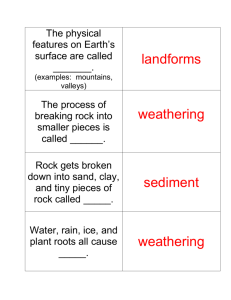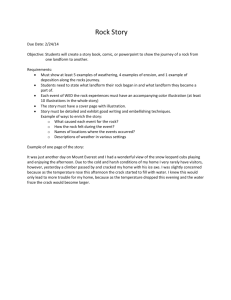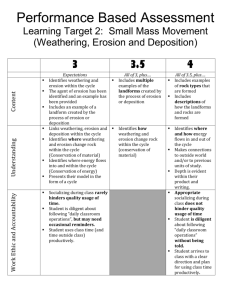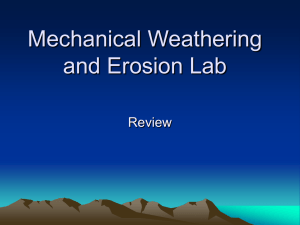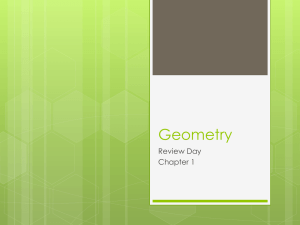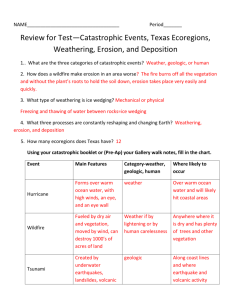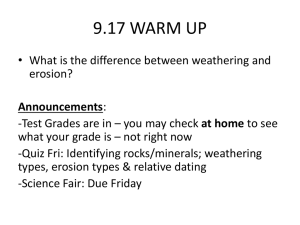Evaluation Strategies
advertisement
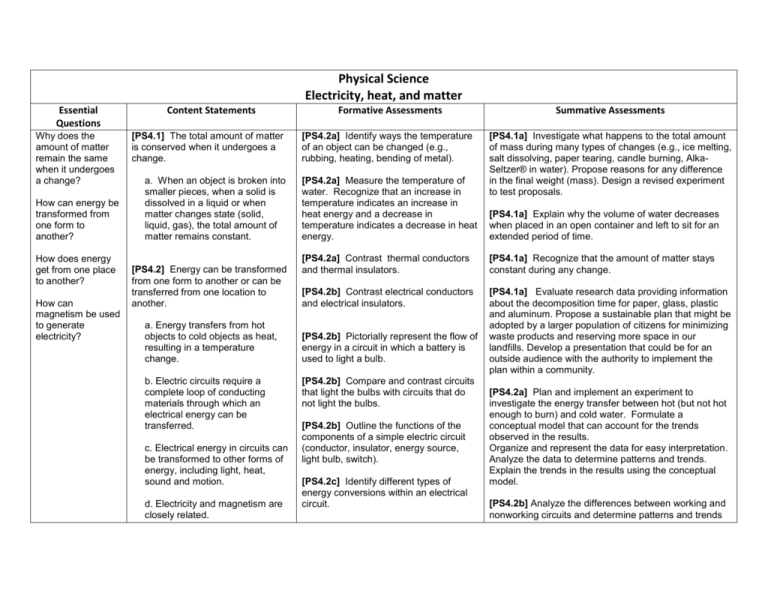
Physical Science Electricity, heat, and matter Essential Questions Why does the amount of matter remain the same when it undergoes a change? How can energy be transformed from one form to another? How does energy get from one place to another? How can magnetism be used to generate electricity? Content Statements [PS4.1] The total amount of matter is conserved when it undergoes a change. a. When an object is broken into smaller pieces, when a solid is dissolved in a liquid or when matter changes state (solid, liquid, gas), the total amount of matter remains constant. [PS4.2] Energy can be transformed from one form to another or can be transferred from one location to another. a. Energy transfers from hot objects to cold objects as heat, resulting in a temperature change. b. Electric circuits require a complete loop of conducting materials through which an electrical energy can be transferred. c. Electrical energy in circuits can be transformed to other forms of energy, including light, heat, sound and motion. d. Electricity and magnetism are closely related. Formative Assessments [PS4.2a] Identify ways the temperature of an object can be changed (e.g., rubbing, heating, bending of metal). [PS4.2a] Measure the temperature of water. Recognize that an increase in temperature indicates an increase in heat energy and a decrease in temperature indicates a decrease in heat energy. Summative Assessments [PS4.1a] Investigate what happens to the total amount of mass during many types of changes (e.g., ice melting, salt dissolving, paper tearing, candle burning, AlkaSeltzer® in water). Propose reasons for any difference in the final weight (mass). Design a revised experiment to test proposals. [PS4.1a] Explain why the volume of water decreases when placed in an open container and left to sit for an extended period of time. [PS4.2a] Contrast thermal conductors and thermal insulators. [PS4.1a] Recognize that the amount of matter stays constant during any change. [PS4.2b] Contrast electrical conductors and electrical insulators. [PS4.1a] Evaluate research data providing information about the decomposition time for paper, glass, plastic and aluminum. Propose a sustainable plan that might be adopted by a larger population of citizens for minimizing waste products and reserving more space in our landfills. Develop a presentation that could be for an outside audience with the authority to implement the plan within a community. [PS4.2b] Pictorially represent the flow of energy in a circuit in which a battery is used to light a bulb. [PS4.2b] Compare and contrast circuits that light the bulbs with circuits that do not light the bulbs. [PS4.2b] Outline the functions of the components of a simple electric circuit (conductor, insulator, energy source, light bulb, switch). [PS4.2c] Identify different types of energy conversions within an electrical circuit. [PS4.2a] Plan and implement an experiment to investigate the energy transfer between hot (but not hot enough to burn) and cold water. Formulate a conceptual model that can account for the trends observed in the results. Organize and represent the data for easy interpretation. Analyze the data to determine patterns and trends. Explain the trends in the results using the conceptual model. [PS4.2b] Analyze the differences between working and nonworking circuits and determine patterns and trends in the experimental evidence. [PS4.2b/c] Design and construct a switch that can turn a light on and off in a circuit. Earth and Space Science Earth’s surfaces Essential Questions What causes change in our physical world? How can we use fossil evidence to decode Earth’s history? Content Statements [ESS4.1] Earth’s surface has specific characteristics and landforms that can be identified. a. About 70 percent of the Earth’s surface is covered with water and most of that is the ocean. Only a small portion of the Earth’s water is freshwater, which is found in rivers, lakes and ground water. b. Earth’s surface can change due to erosion and deposition of soil, rock or sediment. Catastrophic events such as flooding, volcanoes and earthquakes can create landforms. [ESS4.2] The surface of Earth changes due to weathering. a. Rocks change shape, size Formative Assessments Summative Assessments [ESS4.1a] Recognize that 70 percent of Earth’s surface is water, which is why Earth is known as the Blue Planet. [ESS4.1b] Using topographic or aerial maps, locate areas that have been formed through deposition and erosion. Include areas of Ohio that have been impacted by glacial ice or movement. Discuss findings with the class. [ESS4.1b] Identify common landforms from maps or graphics. [ESS4.2a] Identify weathering as processes that change rock at or near Earth’s surface. [ESS4.2a] Recognize that weathering can occur at different rates. [ESS4.2a, 4.3a, & 4.3b] Identify the processes that can change the surface of Earth (e.g., erosion, deposition, volcanic activity, earthquakes, glacial movement and/or weathering). [ESS4.2/4.3] Differentiate between weathering and erosion. [ESS4.2/4.3] Compare and contrast erosion and deposition. [ESS4.2a] Plan and implement an experiment to model and compare different types of weathering and/or rates of weathering that can occur. [ESS4.2a] Using LANDSAT data, research and locate a specific major landform or geographical feature on Earth that formed through erosion or deposition. Represent findings graphically or orally to the class. [ESS4.2a] Using geologic, topographic or aerial maps, research areas in the U.S. that are impacted by natural sinkholes, caverns or caves. Collect data regarding the characteristics of these regions. Compare and contrast the data to determine common characteristics that are present in each area. Represent findings graphically. [ESS4.3a] Plan, build and use a model (such as a small-scale stream table) that can demonstrate the and/or form due to water or ice movement, freeze and thaw, wind, plant growth, gases in the air, pollution and catastrophic events such as earthquakes, mass wasting, flooding and volcanic activity. [ESS4.3] The surface of Earth changes due to erosion and deposition. a. Water, wind and ice physically remove and carry (erosion) rock, soil and sediment and deposit the material in a new location. b. Gravitational force affects movements of water, rock and soil. [ESS4.3a] Identify erosion as a process that transports rock, soil or sediment to a new location. [ESS4.3a] Identify deposition as the settling or coming to rest of transported rock, soil or sediment. [ESS4.3a] Recognize that water, wind, pollution/gases in the air, ice movement, earthquakes, volcanoes, freezing/thawing and plant action can all weather rock and soil. formation of a landform or feature that formed through contact with water (alluvial fan, sinkhole, mid-channel bar, canyon, valley, depositional islands). Ask: What factors accelerate the processes? What factors must exist for the landform to form? Share findings with the class. [ESS4.3a] Use actual geologic data from a specific location, such as the Grand Canyon. Research the formation of the canyon. Ask: Why does some rock weather and erode faster than others? What caused the weathering and erosion in the canyon? How can the age of the canyon be estimated? Use the research data to make a geologic cross section (3-D or virtual model or a graphic) to model the canyon. [ESS4.3a] Using a surficial geology map of Ohio, trace the patterns of glacial movement that can be recognized by a variety of glacial deposits or erosion. Build a model to investigate the movement of glacial ice that creates a similar pattern. Ask: What factors must exist to support the movement of glaciers? Why is glacial movement erosional and depositional? [ESS4.3b] Sediment fences are often placed around construction sites to help control sediment from moving offsite (erosion) into the surrounding environment (deposition). Design and construct a model of one specific sediment-control measure (using scientific research). Evaluate and test it using different types of materials. Different groups in the class should model different methods of control. Each group should present findings and demonstrate the models. [ESS4.3b] Research a specific weathering feature (such as a sinkhole or cave). Evaluate the risk of collapse and methods of prevention of collapse (using actual data) and recommend one solution based on the scientific data. Create a model (virtual, graphic or 3-D) of the actual cave or sinkhole and demonstrate the risk of collapse and how the suggested preventative measure or solution impacts that risk. Evaluation Rationale These formative and summative evaluations, adapted from the Ohio Revised Academic Content Standards Model Curriculum, align with contextual teaching and learning. The various assessments provide opportunities for students to show what they know by applying new concepts in meaningful ways. Students are challenged to research, design, and create solutions to societal issues surrounding classroom topics.

